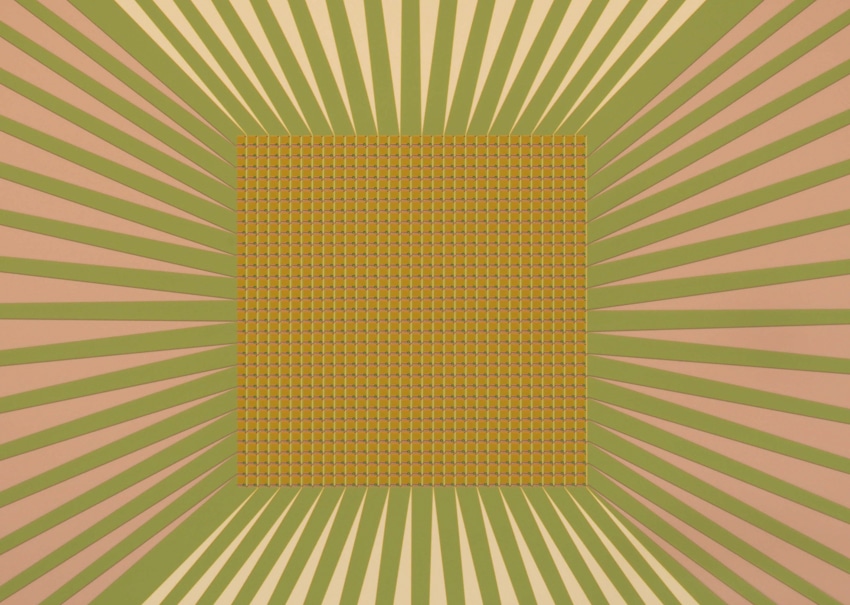Nov 20 2019
For the first time, scientists at the National Institute of Standards and Technology (NIST) have developed one of the highest-performance cameras made up of sensors that count single particles of light, or photons.
 Micrograph of NIST’s high-resolution camera made of 1,024 sensors that count single photons, or particles of light. The camera was designed for future space-based telescopes searching for chemical signs of life on other planets. The 32-by-32 sensor array is surrounded by pink and gold wires connecting to electronics that compile the data. Image Credit: V. Verma/NIST.
Micrograph of NIST’s high-resolution camera made of 1,024 sensors that count single photons, or particles of light. The camera was designed for future space-based telescopes searching for chemical signs of life on other planets. The 32-by-32 sensor array is surrounded by pink and gold wires connecting to electronics that compile the data. Image Credit: V. Verma/NIST.
Featuring over 1,000 pixels, or sensors, the camera developed by the NIST team could prove handy in upcoming space-based telescopes looking into other planets for any chemical sign of life. The camera may also be useful in the latest instruments developed to look for the mysterious “dark matter.” Dark matter is assumed to represent a majority of the “stuff” existing in the universe.
The camera has been described in Optics Express. It contains sensors that are produced from superconducting nanowires. These nanowires are capable of detecting single photons and are among the most ideal photon counters in terms of efficiency, speed, and range of color sensitivity. These detectors were used by the NIST team to illustrate, for instance, Einstein’s “spooky action at a distance.”
Among all types of photon sensors, the nanowire detectors also exhibit the lowest dark count rates. That means these devices do not count false signals that are induced by noise instead of photons. This aspect is specifically useful for space-based astronomy and dark-matter research.
However, these applications require cameras that have more pixels and larger physical dimensions than available before. Moreover, the cameras need to locate light at the extreme end of the infrared band, with wavelengths that are longer than presently feasible.
The camera developed by the NIST team has a compact size, that is, a square measuring only 1.6 mm on a side but integrated with 1024 sensors (32 columns x 32 rows) to create high-resolution images. But identifying a way to acquire and collate results from a large number of detectors without overheating represented a major challenge.
The scientists extended a “readout” design that they had demonstrated earlier with a smaller camera made up of 64 sensors. This “readout” architecture adds up the data from the columns and rows, bringing investigators one step closer to fulfilling the demands of the National Aeronautics and Space Administration (NASA).
My primary motivation for making the camera is NASA’s Origins Space Telescope project, which is looking into using these arrays for analyzing the chemical composition of planets orbiting stars outside of our solar system.
Varun Verma, Electronics Engineer, National Institute of Standards and Technology
Verma pointed out that every chemical element in the atmosphere of the planet would absorb an exclusive set of colors.
“The idea is to look at the absorption spectra of light passing through the edge of an exoplanet’s atmosphere as it transits in front of its parent star,” he explained. “The absorption signatures tell you about the elements in the atmosphere, particularly those that might give rise to life, such as water, oxygen and carbon dioxide.”
The signatures for these elements are in the mid- to far-infrared spectrum, and large-area single-photon counting detector arrays don’t yet exist for that region of the spectrum, so we received a small amount of funding from NASA to see if we could help solve that problem.
Varun Verma, Electronics Engineer, National Institute of Standards and Technology
Verma and collaborators obtained high fabrication success, with as much as 99.5% of the sensors functioning appropriately. However, the detector had a low efficiency at the required wavelength. Therefore, the next challenge was to improve the detector efficiency. The team is also hoping to develop even larger cameras, maybe one that has a million sensors.
Other types of applications are also viable. For instance, the cameras developed by the NIST team can help in locating dark matter. Globally, scientists have not been successful in locating the so-called weakly interacting massive particles, or WIMPs, and are contemplating to look for dark matter that has lower mass and energy.
With the help of superconducting nanowire detectors, emissions of rare and low-energy dark matter could be counted and actual signals can be distinguished from the background noise.
The researchers used a complex process to develop the new camera at NIST’s Microfabrication Facility located in Boulder, Colorado. The superconducting nanowire detectors are developed on silicon wafers sliced into chips. Additionally, the nanowires are composed of a tungsten-silicon alloy and measure approximately 3 nm thick, 3.5 mm long, and 180 nm wide. The wiring is formed of superconducting niobium.
The performance of the new camera was quantified by the Jet Propulsion Laboratory (JPL) at the California Institute of Technology in Pasadena, California. The laboratory stocks the required electronics because of its focus on deep space optical communications.
NASA and the Defense Advanced Research Projects Agency supported the study.
NIST researcher Varun Verma explains how a new NIST camera, made of nanometer-scale wires, could efficiently capture light from atmospheres of extrasolar planets that possibly harbor life. Video Credit: NIST.